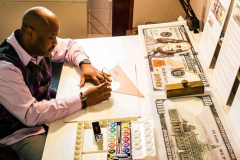Brian Thompson’s latest artwork has taken 17 years to create. But when the piece is unveiled this fall, millions will see and touch it.
Mr. Thompson designs paper money at the Bureau of Engraving and Printing in Washington—most recently the new $100 bill, which started to circulate on Oct. 8.
The note will still feature Benjamin Franklin on its face and Philadelphia’s Independence Hall on its back. Much of the rest reflects Mr. Thompson’s choices: He wanted to give the bill more movement and an airier feel than “Benjamins” have now. And he hoped to evoke more U.S. history by adding well-known imagery, such as the Declaration of Independence—while incorporating new anticounterfeiting features.
“It’s like putting a puzzle together,” said Mr. Thompson on a recent morning at his drafting desk in the Bureau’s neoclassical building near the National Mall. “In a puzzle, you have to have each piece in the right place to get a whole picture.”
When finished, that picture will be among the most recognized across the globe. At the end of 2012, 8.6 billion $100 bills were in circulation, according to the Federal Reserve. Up to two-thirds of U.S. currency circulates abroad, and the $100 note is a favorite of foreign counterfeiters. That’s why on the door to Mr. Thompson’s studio is a red sign that says “High Security Area.” Underneath it, he has added a small poster. “Bank-note design is old-world craftsmanship,” it reads.
Just over a century ago, Theodore Roosevelt hired sculptor Augustus Saint-Gaudens to redesign currency; his work with gold coins is famous. But most designers haven’t been celebrities. A 43-year-old Washingtonian, Mr. Thompson started drawing in the third grade and went to a high school for the arts. In college, he apprenticed at the Bureau of Engraving and Printing. In 1989, he began to help redesign the $20 bill (which was issued four years later) and never left.
Mr. Thompson finds the size of paper currency a challenge: Only postage stamps, he jokes, have less space for artistic expression. The images must be easily recognizable, the colors vibrant and the numbers big enough to prevent confusion. His favorite bank-notes include those of Australia and South Africa, with their vivid, subtly blended colors. For inspiration, he looks to the fantastical engravings of M.C. Escher and the brilliantly detailed flowers of Georgia O’Keeffe.
Mr. Thompson started working on the new bill in 1996, after the current $100 note was issued. He began with a series of sketches. Because he wanted to include the Declaration of Independence, which Franklin signed, one sketch showed a wavelike scroll with a large quill. But in the end there wasn’t room for the scroll. Instead, the Declaration’s words fill the right side of the note.
The quill is paired with an inkwell that has an image of the Liberty Bell inside it. The bell doubles as a security mark, changing from green to copper, appearing and disappearing, depending on the angle of the light. In addition, Mr. Thompson incorporated the date of the declaration’s adoption, July 4, 1776. “That was the push, to really tell a story this time,” he said.
To add space and flow, Mr. Thompson thinned the black frame around the bill’s edges and eliminated the frame around Franklin’s portrait: “I wanted something more airy and free.” He also gave shoulders to Franklin, so that the viewer’s eye would move, in a continuous curve, from the lower left of the note to the security ribbon and historic symbols above on the right.
A committee with representatives of the Bureau of Engraving and Printing, the Fed, the U.S. Secret Service and the Treasury recommends the design to the secretary of the Treasury, who has the final say. It took 40 drafts to reach a final version.
The same panel advised on how to foil counterfeiters, a key aim of the redesign. Mr. Thompson said that the aesthetic challenge was to keep the necessary signatures, symbols and security marks from turning the bill into a piecemeal collage. “It’s a balancing act,” he said.





